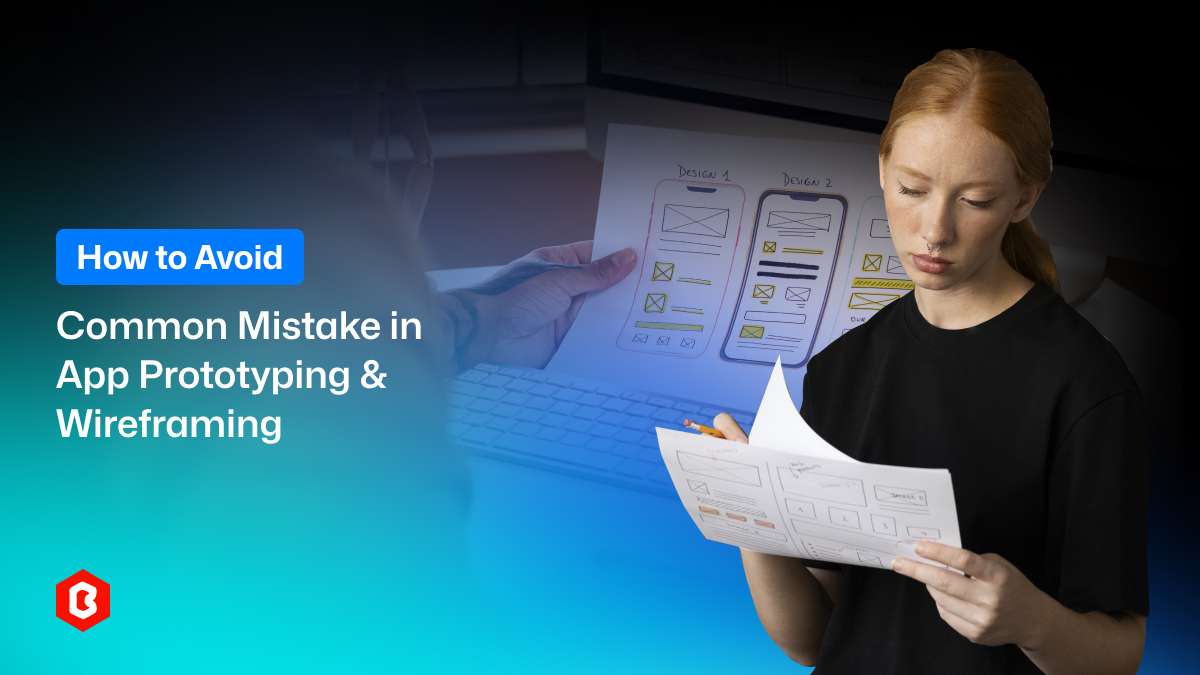Black Friday Special! Buy any 1 product and get 1 absolutely free — this offer applies to all Website Templates, UI Kits, and Complete Scripts.
Buy Now!
Making professional apps starts before any coding happens. It begins with planning. Prototyping an app and wireframing it help businesses shape how the app will feel. They show how users will move through the app and what the app will do. However, many teams make mistakes during this step. These mistakes can lead to wasted time, lost money, and confusion later.
In this article, we break it into two key sections:
Common Mistakes in App Prototyping and Wireframing
How to Avoid Them
Lack of structure and flow: Skipping wireframing an app can lead to a messy layout and confusing navigation. You must learn the basics of how to create wireframes.
No visual roadmap: It’s tough to get everyone on the same page about how the app should work without early visuals.
Frequent rework: Moving directly into design or development often results in big changes later, wasting time and effort.
Focusing too much on looks: An early wireframe application should focus on layout and how the app works, not colors or styling.
Confusing stakeholders: Showing detailed designs too soon can make stakeholders think the app is almost done.
Slower changes: Adding visual details too early makes it harder to test or adjust ideas quickly.
Disconnected screens: If you don’t plan the user journey, screens can feel out of place and hard to navigate, with no clear flow from one to the next.
Missing important steps: Simple things like password recovery or handling failed transactions can easily be forgotten, leaving users frustrated when they need them most.
Frustrating experience: When core features and flows aren’t considered from the start, users can easily get stuck or confused, leading to a poor experience.
Late-stage surprises: Without early input, major usability issues often come out only during development.
Unmet expectations: Stakeholders may have different visions that only come out once visuals are shown.
Wasted resources: Time and money go into building features that don’t connect with the target audience.
Limited usability testing: If key flows are missing, it’s hard to gather meaningful user feedback.
Unrealistic demos: Stakeholders can't experience the app’s full functionality, leading to unclear decisions.
Poor handoff to development: Developers may lack the context needed to build the complete product.
Miscommunication with developers: Without annotations, developers have to guess how elements are supposed to behave.
Lack of interaction clarity: Buttons, transitions, and states can be misunderstood without proper notes.
Delays in implementation: Developers may repeatedly seek clarification, slowing down the build process.
Professional designers know how to prototype UX, and wireframe applications, and translate ideas into usable, logical layouts.
Work with expert providers like Bitrix Theme who understand user behavior and usability.
Eliminate guesswork with structure-focused, goal-driven layouts.
Ensure each screen supports a smooth and consistent experience.
Ready-made UI kits provide pre-designed, customizable screens that speed up the design process without compromising quality.
Launch faster with screens built for common app use cases.
Customize components to match your brand and user flow.
Maintain design consistency across every part of your app.
Mapping out user flows first ensures every screen serves a purpose and supports a seamless app experience.
Define step-by-step how users move through the app.
Identify which screens and actions are essential to complete goals.
Prevent design gaps and disconnected navigation.
Interactive prototypes let you validate ideas, identify usability issues, and get real feedback before development begins.
Spot probable friction points in the user journey early on.
Validate your layout and functionality with real users or clients.
Reduce costly redesigns by learning what works (and what doesn’t).
Wireframing an app helps it adapt smoothly across phones, tablets, and modern foldable devices.
Ensure layouts scale properly for different resolutions and orientations.
Avoid issues like broken elements or awkward spacing.
Provide a consistent and polished experience across all devices.
Clear annotations and handoff documents ensure developers understand how each element works, reducing errors and delays.
Explain how buttons, forms, and transitions should behave.
Include logic for interactions, states, and screen flows.
Make handoffs smoother with clean files ready for development.
Good professional apps start with smart planning, not just coding. Wireframing and prototyping an app help you understand how the app will look and work before building it. Learning how to create wireframes and avoiding early mistakes saves time, money, and extra work later. Whether you hire professionals or use a ready-made app UI kit, starting with the right steps makes the whole process easier and more successful.
Making professional apps starts before any coding happens. It begins with planning. Prototyping an a...
Using a Multipurpose HTML website template in development is not just a shortcut but a smart way to...
Now, e-commerce is not just a game of “uploading the products and praying for conversions.&rdq...
CSS has come a long way. Gone are the days when designers and developers depend on floats, clearfix...
Artificial Intelligence has revolutionized the Website User Interface (UI) and User Experience (UX)....
UI designers rely on various design tools to create their projects. There are many tools available o...

Not sure which template or UI kit fits your project? Reach out for expert advice.